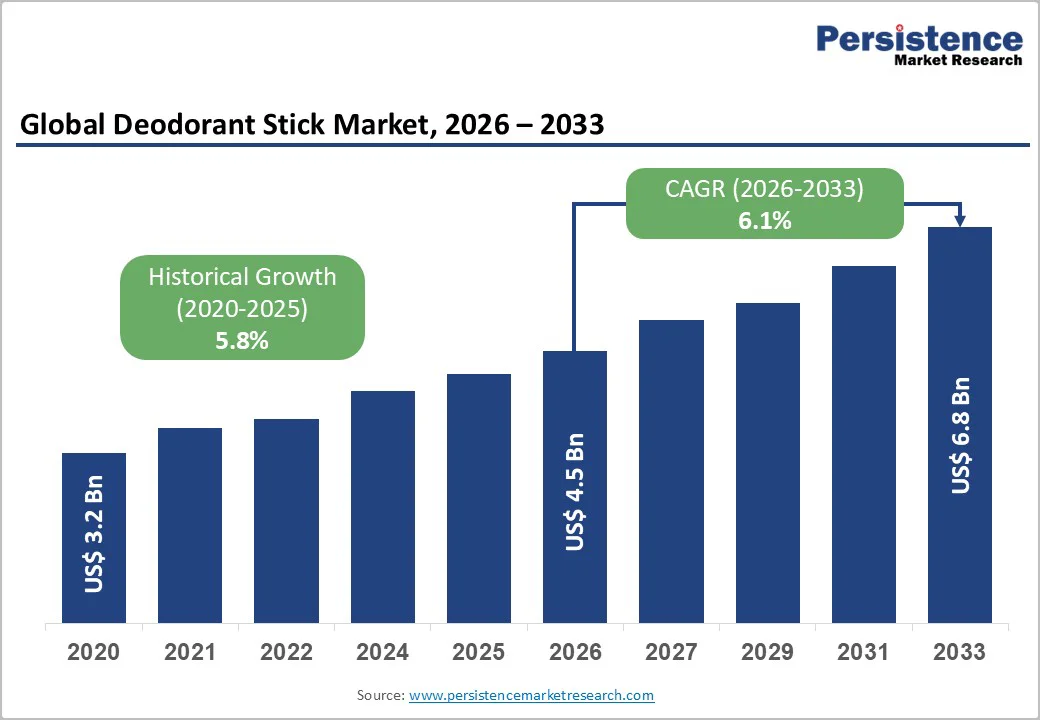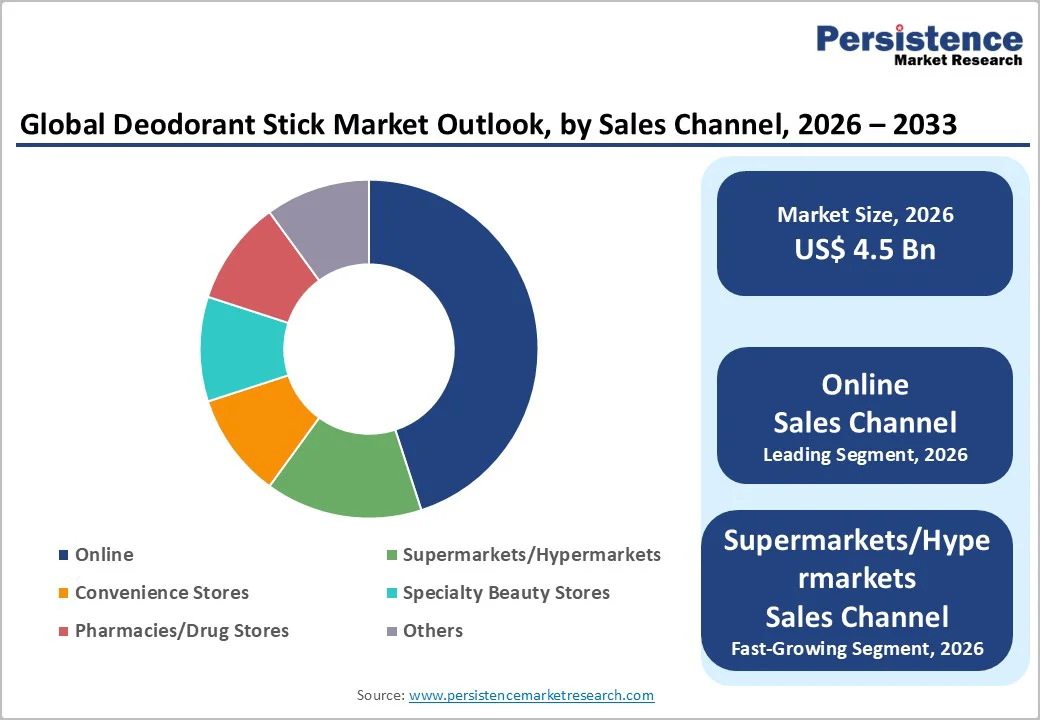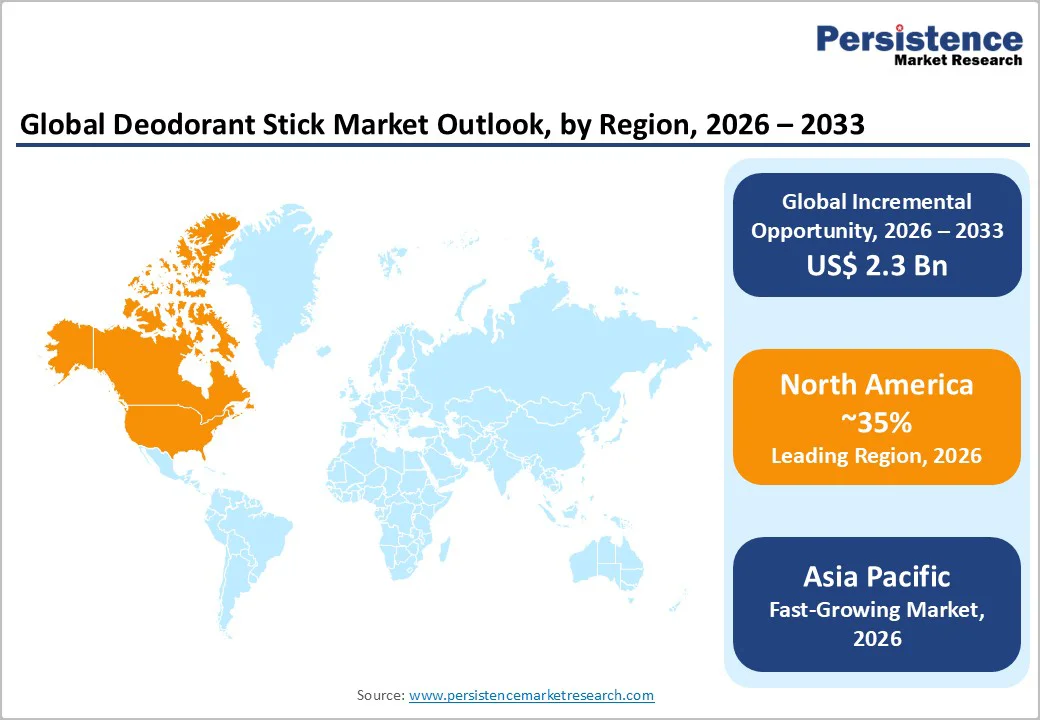ID: PMRREP34184| 199 Pages | 13 Dec 2025 | Format: PDF, Excel, PPT* | Consumer Goods

The global deodorant stick market size is likely to be valued at US$4.5 billion in 2026, and is expected to reach US$6.8 billion by 2033, growing at a CAGR of 6.1% during the forecast period from 2026 to 2033, driven by the increasing prevalence of personal hygiene awareness, rising demand for natural/organic formulations in daily grooming, and advancements in skin-friendly delivery systems.
Growing demand for convenient, long-lasting deodorant sticks, especially for sports & fitness, is accelerating the adoption across demographics. Advances in antiperspirant and alcohol-free sticks are further boosting uptake by offering more effective, irritation-free options. Increasing recognition of deodorant sticks as critical for confidence in urban lifestyles remains a major driver of market growth.
| Key Insights | Details |
|---|---|
|
Deodorant Stick Market Size (2026E) |
US$4.5 Bn |
|
Market Value Forecast (2033F) |
US$6.8 Bn |
|
Projected Growth (CAGR 2026 to 2033) |
6.1% |
|
Historical Market Growth (CAGR 2020 to 2025) |
5.8% |

The rising preference for personal hygiene awareness is quickly becoming a major opportunity for deodorant brands, driven by growing consumer demand for clean, skin-safe products and reduced irritation. Traditional aluminum-heavy sticks often cause concerns, such as clogged pores, especially among sensitive skin users, leading to lower compliance and skin issues. Natural/organic technologies, including plant-based deodorant sticks, alcohol-free variants, probiotic-infused formulas, essential oil blends, and hypoallergenic sticks, address these concerns by offering gentle, effective alternatives. These formats simplify application, reduce the need for frequent reapplication, and are particularly effective during active routines or travel, where a quick refresh is critical.
Natural deodorant sticks significantly lower the risk of allergic reactions, residue buildup, and environmental harm, which remain major concerns in personal care settings. They also support improved skin microbiome balance and easier storage, especially for scented and unscented sticks, making them ideal for urban or on-the-go consumers. As global wellness organizations push for broader hygiene coverage and user-friendly grooming methods, demand continues to expand across daily use, sports & fitness, and sensitive skin applications.
High development and formulation costs present a significant barrier for companies advancing next-generation deodorant sticks and novel skin-delivery systems. Developing innovative variants such as natural/organic, alcohol-free, or probiotic-based deodorant sticks requires extensive research, specialized botanicals, and advanced manufacturing technologies that are far more expensive than traditional antiperspirant platforms. Efficacy is an even greater challenge: many clean formulas, essential oil constructs, and mineral-based sticks are sensitive to humidity, temperature, and pH, requiring rigorous optimization to ensure they remain potent throughout storage and use. Achieving long-term stability often involves costly stability trials, sophisticated dermatological testing, and the use of high-grade natural stabilizers, which significantly increase R&D expenditures.
Meeting stringent regulatory expectations for safety data, shelf life, and batch consistency requires multiple clinical studies under various conditions and across several production batches. This adds both time and financial burden to development timelines. Scaling up manufacturing requires controlled environments, specialized equipment, and quality-assurance systems, further driving up overall costs. For smaller beauty companies, these challenges can limit pipeline expansion or delay commercialization.
Advancements in skin-friendly and probiotic deodorant delivery platforms are transforming the global grooming landscape by addressing two major challenges: irritation dependence and chemical-based application barriers. Skin-friendly sticks are engineered to maintain efficacy at neutral pH levels, reducing reliance on harsh actives and enabling safe use for sensitive skin or daily routines. Innovations, such as crystal mineral formulations, lipid-based emollients, microbiome engineering, and essential oil optimization, significantly improve gentleness and reduce spoilage, lowering logistical costs for beauty systems and consumer campaigns.
Progress in probiotic delivery platforms, including fermented extracts, unscented gels, cream sticks, and microbiome-targeted balms, supports more natural odor neutralization by stimulating the skin's protective barrier, the body’s first line of defense against bacteria and sweat. These formats eliminate irritants, enhance user compliance, and allow self-application without trained professionals, making them highly suitable for mass grooming programs. New technologies such as nanoparticle carriers, bio-adhesive polymers, and plant-derived deodorant sticks further enhance absorption and freshness response.
Antiperspirant deodorant sticks are anticipated to dominate the market, accounting for approximately 40% of the market share in 2026. Its dominance is driven by robust sweat control, cost-effectiveness, and familiarity, making it preferred for daily and sports use. Antiperspirant deodorant sticks provide pore-blocking protection, ensure all-day efficacy, and contribute to confidence, making them suitable for large-scale consumer campaigns. For example, companies such as Procter & Gamble produce antiperspirant sticks for urban professionals, protecting against odor while supporting mass grooming programs that are both scalable and effective.
Natural/organic deodorant sticks represent the fastest-growing segment, due to their gentleness and expanding use in sensitive skin applications. Their strong safety profile makes them ideal for targeted freshness, reducing adverse effects. Continuous innovations in botanical adjuvants are further strengthening their performance, driving rapid adoption across North America and Europe, where demand for next-generation, clean-label sticks is accelerating. Native (Procter & Gamble) expanded its natural deodorant stick line in 2025 with plant-based, aluminum-free formulations featuring coconut oil and shea butter, gaining strong traction among sensitive-skin consumers seeking clean-label alternatives.
The daily use segment leads the market, holding approximately 50% of the share in 2026, driven by persistent routine needs, large grooming programs, and strong global demand for convenient protection. Their dominance continues as consumers expand their use for work, travel, and casual wear. Rising adoption of scented variants and expanded natural campaigns highlight the growing focus on everyday freshness. For example, companies such as Unilever supply sticks products such as Dove for large-scale daily routines, reducing odor incidence and supporting personal confidence strategies across multiple regions.
The sports & fitness segment is the fastest-growing segment, due to strong momentum in active lifestyles and expanding inclusion of sweat-resistant sticks in fitness routines. The growing shift toward alcohol-free and clinical strength platforms, along with better skin tolerance, accelerates the adoption. Advancements in long-lasting probiotic sticks and continued progress of performance-enhancing formulas entering consumer trials drive market growth. For example, Unilever’s Degree Advanced MotionSense Sports Deodorant Stick, expanded in 2025, uses sweat-activated microsensors to deliver long-lasting protection for athletes and gym-goers, strengthening product demand within the active lifestyle category.
The online segment is expected to dominate the market, contributing nearly 45% of revenue in 2026, due to remaining the primary hubs for discovery, personalized recommendations, and management of diverse consumer preferences requiring virtual trials. Their strong infrastructure, user reviews, and ability to handle global or specialized sticks drive higher volume. Online platforms are leading natural and scented stick rollouts, as well as featuring emerging organic stick trials. For example, large e-commerce systems such as Amazon routinely conduct promotions for daily and sports sticks while also participating in subscription trials for personalized deodorant sticks, ensuring consumers receive tailored, convenient care with high satisfaction standards.
Supermarkets/Hypermarkets represent the fastest-growing segment, driven by their strong community presence and expanding role in impulse personal care purchases. They offer convenient, quick, and accessible grooming services, attracting shoppers who prefer in-store, low-wait-time settings. Increased outreach programs, a preventive-care focus, and wider availability of routine and travel stick further accelerate footfall, boosting rapid adoption across both urban and semi-urban areas. For example, retail chains such as Walmart provide walk-in sections for antiperspirant and natural sticks, making grooming more accessible to local populations while reducing pressure on specialty stores. Tesco in the U.K. expanded its shelf space for natural and aluminum-free deodorant sticks in 2025, featuring brands such as Dove, Nivea, and Native, which significantly increased consumer visibility and supported rising demand for clean-label grooming products.

North America is projected to lead, accounting for nearly 35% of the market share in 2026, driven by the region’s advanced retail infrastructure, strong research and development capabilities, and high public awareness of hygiene benefits. Retail systems in the U.S. and Canada provide extensive support for grooming programs, ensuring wide accessibility of deodorant sticks across daily use, sports, and sensitive-skin populations. Increasing demand for natural/organic, convenient, and easy-to-apply sticks is further accelerating adoption, as these formats improve user compliance and reduce barriers associated with traditional sprays. For example, Unilever expanded its Dove 0% Aluminum Deodorant Stick range across the U.S. and Canada in 2024, offering gentle, non-irritating, and clean-label formulations that became highly popular among health-conscious and sensitive-skin users.
Innovation in deodorant stick technology, including stable formulations, improved scent delivery, and targeted microbiome protection, is attracting significant investment from both public and private sectors. Government initiatives and wellness campaigns continue to promote grooming against everyday odor, seasonal sweat, and emerging skin concerns, creating sustained market demand. The growing focus on clinical-strength and unscented solutions, particularly for active and sensitive demographics, is expanding the target population for deodorant sticks and reinforcing North America’s leadership in high-performance grooming products.
Europe is driven by increasing awareness of grooming benefits, strong retail systems, and government-led hygiene programs. Countries such as Germany, France, and the U.K. have well-established personal care frameworks that support routine applications and encourage the adoption of innovative stick delivery methods, including natural and organic deodorant sticks. For example, Beiersdorf expanded its Nivea Naturally Good Deodorant Stick line in 2025 across Germany and France, offering 95% natural-origin ingredients and plastic-reduced packaging to meet rising demand for gentle and sustainable grooming products. These formulations are particularly appealing for daily users, irritant-averse adults, and sensitive-skin populations, improving compliance and coverage rates.
Technological advancements in deodorant stick development, such as enhanced stability, skin-targeted delivery, and improved natural formulations, are further boosting market potential. European health authorities are increasingly supporting research and consumer trials for sticks against both routine and active odor challenges, strengthening market confidence. The growing emphasis on convenient, self-applied grooming options aligns with the region’s focus on preventive wellness and reducing store visits. Public awareness campaigns and promotion drives are expanding reach in both urban and rural areas, while beauty companies are investing in botanicals and novel actives to increase efficacy.
Asia Pacific is likely to be the fastest-growing market for deodorant sticks in 2026, driven by rising hygiene awareness, government-led grooming initiatives, and expanding personal care programs across India, China, Japan, and Southeast Asia. Deodorant sticks are preferred due to their portability, ease of distribution, and suitability for both urban and rural populations. Technological advancements are enabling more stable, effective, and heat-resistant formulations that withstand challenging storage conditions. For example, Unilever’s Rexona (Sure) MotionSense Stick launched new sweat-activated variants in Indonesia and the Philippines, targeting young consumers engaged in sports and outdoor activities, offering stronger durability and sweat protection under tropical climates.
These innovations support large-scale consumer outreach while improving grooming coverage in remote regions. Rising demand for daily, sports, and sensitive-skin applications, coupled with public-private partnerships and increasing beauty expenditure, is accelerating market adoption. Strengthened investment in product research, upgraded manufacturing capacities, and the reduced risk of spills offered by stick formats continue to position deodorant sticks as a preferred delivery option across Asia Pacific.

The global deodorant stick market features competition between established beauty leaders and emerging clean brands. In North America and Europe, Unilever and L’Oréal lead through strong R&D, distribution networks, and retail ties, bolstered by innovative formulations and grooming programs.
In the Asia-Pacific region, Mandom Corporation advances with localized solutions to enhance accessibility. Skin-friendly delivery boosts compliance, reduces the risk of irritation, and enables mass campaigns across regions. Strategic partnerships, collaborations, and acquisitions merge expertise, expand pipelines, and speed commercialization. Natural formulations solve sensitivity issues, aiding penetration in health-conscious areas.
The global deodorant stick market is projected to reach US$4.5 billion in 2026.
The rising prevalence of personal hygiene awareness and demand for natural/organic formulations are key drivers.
The deodorant stick market is poised to witness a CAGR of 6.1% from 2026 to 2033.
Advancements in skin-friendly and probiotic delivery platforms are key opportunities.
Unilever PLC, L’Oréal S.A., Procter & Gamble, Beiersdorf AG, and Mandom Corporation are the key players.
| Report Attribute | Details |
|---|---|
|
Historical Data/Actuals |
2020 - 2025 |
|
Forecast Period |
2026 - 2033 |
|
Market Analysis |
Value: US$ Bn |
|
Geographical Coverage |
|
|
Segmental Coverage |
|
|
Competitive Analysis |
|
|
Report Highlights |
|
By Product Type
By Application
By Sales Channel
By Region
Delivery Timelines
For more information on this report and its delivery timelines please get in touch with our sales team.
About Author